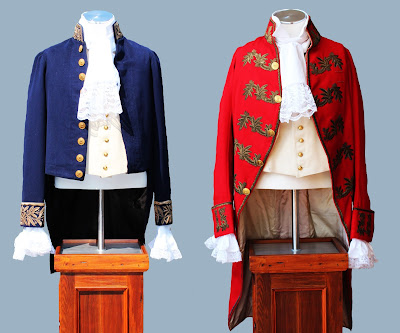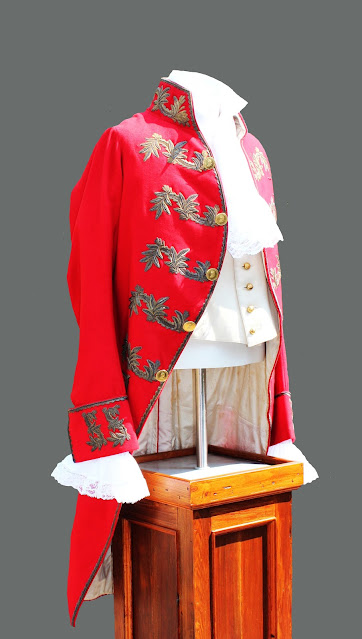I bought this uniform from a longtime collector. It was clear that it was a uniform belonged to a nobel person who was a member of the Knightage Counsel of Utrecht. This can be indicated by the button. This kind of uniform is seldom or not to say, never, been offered on the market.
There is not much to find on the internet about the uniform. So I went to the archives in Utrecht to look into the existing files of the Knightage Counsel Utrecht. A complete new world of history came alive.
It all
started in the middle ages when nobel men where in controle (beside the church)
over the common people. Over the century’s they gained a wild range of privileges
but the way they reign was slightly changed by the new upcoming power: the cities.
But the nobility in Holland was keen enough to take part in the newly political
atmosphere. So three branches where made in 1588; cities, church and the
nobility. It meant a little step backwards but the nobel men where still in
controle. That changes with the French Revolution. They lost all of there powers
and where stript naked as it came to priviliges. With Napoleon in charge nothing
changed to the benefit for the nobility. But in 1815 with Napoleon sent to
St.Helena, Holland crowend his king William I. William however was not willing
to listen to the echo of the French Revolution, like in other countries, and set
the clock backwards. The nobility was once again instituted, just one year later in 1816 as a
reigning power in the Provinces (!) So they regained there power as before the French Revolution. By1850 (after the revoltion periode of 1848 in Europe) the Counsel was abolished permanetly.
On 21 november 1818 (No, 50) King William I granted the Knightage Counsel of the Province of Utrecht to wear, in Dutch, a ' klein (minor) kostuum'. This means either a uniform or suit depending the time and context. It seams that the intention was to wear a costume/suite rather than a uniform. The nobility was wearing his costumes in a pre-revolution way and they want to succeed to that. The only problem was the fact that court costumes where never regulated (apart from uniforms) and Willem I insited that they did. But the nobel men refused to wear an uniform so they asked for regulation of there suites or costume. King William agreed but told the Knightage to draw, design or simply made a discription of there own costume for only the gouverment was responsable for uniforms. And in 1818 the first costume was regulated. It was a so called 'klein kostuum'. That means a minor costume for daily use. A year later the Knightage Counsel was granted a red major costume, called the court dress and only to be worn when visiting the court of William I. The discription (axtracted from the archives and formal decreet no.50) of the blue minor dress is as follows:
a. a blue 'frak',
b. embroidered with a laurel leave on the collar and cuffs,
c. buttons with a helmet reading: Ridderschap der Provincie Utrecht,
d. a white vest,
e. grey pair of trousers or white knee trouser with white silk stockings,
f. if the grey trousers where in use men should wear a pair of black high boots with gilded spurs,
g. a head with white plume and gold wire thread,
h. a gilded court sword.
The drawing of the laurel in the archives
This means that the blue uniform (actually a suit) is the minor one. But it is completely wrong according to the discription. It is a uniform instead of a suit. The name on the button is abbreviated. The pocket flaps are also embroidered. and the style is late 19e or beginning 20th century. It should have looked like the picture on the right. So what went wrong? I contacted the well know musea who have a large collection of Dutch civil uniforms. And just one had precisly the same uniform. We compered the foto's and came to the conclusion that both where made by the same tailor. The curator told me that 3 pairs of uniforms (the minor blue one and the major red court dress) where made by Van Zanten in Zeist in or around 1910 (!). The museum owned the blue uniform but not the red court dress. Two red court dresses are in the museum Het Loo at Apeldoorn and one red court dress resides in the museum Van Loon. So they are not longer available for the collectors market. The other blue uniform is either gone for good or in private hands. But if this is a 1910 uniform where are the suits or costumes from 1818/1819? But first let us go to the red court dress of the Knightage Counsel,
At 30 august 1819 (No. 8) king William I granted the Counsel to wear, in Dutch, 'groot (major) kostuum'. That is the dress/suit or costume that is only to be worn at his majesty court. The specifics are:
a. scarlet red 'frak',
b. five in gold wire embroidered bows in front, gold wire embroidered bows on the collar and the same on the cuffs,
c. a white vest en knee trousers,
d. a head with white plume and gold wire thread
e. an 'old' knightly court sword (same as for the minor costume).
No museum in the Netherlands have a 1819 court dress so we are depending on the three red ones from 1910.
It is obvious that this dress is, like the blue coat, not made by the discription. It is a fantasy suite with the pretention to be of the Kightage Counsel of Utrecht. The embroidery is once again the laurel leaf (!?) but now in a way that fits no regulations. There are five buttons attached on the wrong side of the coat. Why did Van Zanten make this fantasy uniform? He clearly did not know how to make it. I found in the archives the original drawings of the embroidered bows.
Embroidery for the front and collar
Embroidery for the cuffs
This kind of type of uniform embroidery is not common and used only once before around 1816. At the Rijksmuseum of Amsterdam I looked into the book with the original design.
It was used for an officer of the General-staff. In the same book there where two drawings wiche gave an idea about the coulors.
What we can clearly see is the used embroidery but more intresting is the coulor. A blue jacket with a grey pair of trousers and scarlet collar and cuffs. So it was quite obvious that the Knightage Counsel was inspired by the military but have to turn it into a civil way to use. The military jacket was stripped of its epaulettes. That is the most simple cosmetic surgery. Then the jacket it self has to be tailored in the pre-revolution version of civil clothing what was in that time (1818) the normal way of men's clothing. The minor dress became blue and the major dress scarlet red as like the collar and cuffs.
How did it look around 1819? I was making an artist impression when I received a call from a long-time friend and collector who came aware about my blue uniform. He told me that he knew someone with two old, that means over 200 years old, uniforms who had them in the family for almost half a century. It was years ago when he tried to buy them. But the owner was reluctant do so. In his recollection one of the uniforms was unusely long and red. I got the adres, made an appointment, and the man was very nice and willing to show me the uniforms. And there it was: the major scarlet dress tailored in 1819.
Did I get the opportunity to buy this dress from the man?. Yes. I have the piece but it was not a bargain.
What is it worth? Well, there are not many collectors who like such a typical Dutch object and can not sleep without the possession of it. So the blue minor coat is around 400 euro's allthough it is in prisitne condition. But on the other hand the red one is a piece of clothing ('habit de cour') arond the turn of the century while Napoleon still living. That has it's influence on the price more then collecting court dresses from the Netherlands,































































































